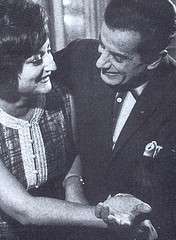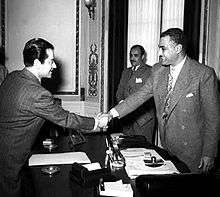Farid al-Atrash
| Farid al-Atrash فريد الأطرش | |
|---|---|
|
Farid al-Atrash | |
| Background information | |
| Born |
October 19, 1910 Al-Suwayda, Vilayet of Syria, Ottoman Empire |
| Origin | As-Suwayda, Syria |
| Died |
December 26, 1974 (aged 64) Beirut, Lebanon |
| Genres | Arabic, Egyptian classical, instrumental |
| Occupation(s) | Singer, actor, composer, instrumentalist |
| Instruments | Singing, oud |
| Years active | 1930s–1974 |
| Associated acts | Asmahan |
| Website |
www |
Farid al-Atrash (Arabic: فريد الأطرش; October 19, 1910 – December 26, 1974), also written Farid Elattrache, was an Egyptian composer, singer, virtuoso oud player, and actor of Syrian origins, who lived in Egypt.[1][2] Having immigrated to Egypt at the age of nine years old with his mother and siblings childhood, Al-Atrash embarked on a highly successful career spanning more than four decades—recording 500 songs and starring in 31 movies. Sometimes referred to as "King of the Oud", he is one of the most important figures of 20th century Arab music.[3]
Early life
Al-Atrash was born in al-Suwayda, in southern Syria to the Druze al-Atrash family who fought the French colonial army.[4] His father was Syrian and his mother was Lebanese.[5] As a child, al-Atrash emigrated with his mother and siblings to Egypt, escaping the French occupation. Later, they were naturalized by the Egyptian government as citizens. Farid's mother sang and played the Oud, which spurred his musical interest at an early age.
As a child and young adult, al-Atrash sang in school events. He studied in a music conservatory and became an apprentice of the renowned composer Riyad as-Sunbaty. In the 1930s, al-Atrash began his professional singing career by working for privately owned Egyptian radio stations. Eventually, he was hired as an oud player for the national radio station and later as a singer. His sister, Asmahan, was also a talented singer, and for a while they worked together. In 1941, they starred in their first successful movie Intisar a l-Shabab (انتصار الشباب – The Triumph of Youth, 1941), in which Farid himself composed all the music.[6] He died in December 26, 1974, at the age of 64.
Family


Farid and his sister Amal, along with their brother Fou'ad, belonged to the religious minority clan of their parents, Princess Alia and Prince Fahd al-Atrash. (Asmar 1998)
His younger sister, Asmahan, evidenced similar musical talent in her teens, becoming one of the most popular female vocalists and cinema stars in the late 1930s and early 1940s. Farid is better known than Asmahan because her career was interrupted by her death in an accident in 1944. Yet he was initially overshadowed by his sister's talent and popularity. With maturity and the forging of a successful performance formula, Farid became famous in his own right. Even today, reference to the given name "Farid" in the context ofArabic music or popular culture is immediately understood to denote al-Atrash himself. (Zuhur, 2003)
Musical career
Al-Atrash had a long and colorful music career lasting four decades. He composed musically diverse songs, and was a highly regarded composer, singer and instrumentalist. Al-Atrash maintained that although some of his music had western musical influence, he always stayed true to Arab music principles. Although the majority of his compositions were romantic love songs, he also composed several patriotic and religious songs.
One of al-Atrash's most unusual and distinguishable traits was his voice. High and mellow at the start of his career, it evolved into a wider, deeper sound. A person not familiar with his work would find it hard to believe the singer in "Ya Reitni Tir" (1930s) and "Adnaytani Bil Hajr" (1960s) were the same singer. His singing style was deeply passionate.
In many of his songs, and nearly all of his concerts, al-Atrash would sing a mawal, which is a slow voice improvisation of a few poetic lines. These improvisations sometimes lasted up to 15 minutes. The mawal was a favorite of his fans. Some of the most famous songs include "Rabeeh" (Spring), "Awal Hamsa" (first whisper), "Hekayat Gharami" (story of my love), "Albi Wa Moftaho" (my heart and its key), "Gamil Gamal", "Wayak", "Ya Zahratan Fi Khayali" (يا زهرة في خيالي – "Flower of my imagination), "Bisat Ir Rih" (flying carpet), "Ya Gamil Ya Gamil", "Ya Habaybi Ya Ghaybeen", "Eish Anta", and "sa3a bi 2orb el habib" (an hour in company of the beloved).
Film career
Al-Atrash starred in 31 Egyptian musical films from 1941 to 1974. His last movie, Nagham Fi Hayati (نغم في حياتي, Songs in my life) was released after his death. All his films except the last two were black and white. They ranged from comedies to dramas, or a combination. He composed all the songs in his movies including the songs sung by other singers, and instrumentals (usually belly dance routines). His earlier films would include approximately ten songs, but overall the films would average about five songs each. Some of al-Atrash's well-known movies include Intisar al-Shabab (انتصار الشباب – The Triumph of Youth, 1941), Yom Bila Ghad, Ahd el-Hawa, and Lahn al-Kholoud (لحن الخلود – "Eternal Lyric", 1952).
Personal life

Quick success brought the young man a lifestyle of nightclubs, love affairs, and gambling. Soon Farid was in debt and found himself abandoned by his disapproving mother. During this difficult period of his life, he also endured the death of his sister and fellow performer Asmahan. Farid found comfort in a relationship with the belly-dancer Samia Gamal, for whom he was motivated to risk all he owned. In 1947 he produced and co-starred in a movie with Samia directed by Henri Barakat; Habib al-'Oumr ("The love of my life," 1947), which became a huge success. After this came Afrita Hanem ("Madame la diablesse," 1949). Five films later, the unmarried couple broke up. Farid continued to work with other film stars in numerous successful movies in which he always had the romantic lead role of a sad singer. He even repeatedly chose his character's name to be "Wahid," meaning lonely.(Zuhur, 2001)
Al-Atrash refused to get married, claiming that marriage kills art. In his films, the audience remembered his leading ladies and his beautiful songs more than the story lines.
Prior to the 1952 military coup d'état against King Farouk I, al-Atrash became friends with Farouk's consort, Queen Nariman, a relationship that continued after the Queen's divorce and the coup that cost Farouk his throne. The former queen's family did not accept al-Atrash, and the separation from Nariman sent the singer into a long depression, the start of health problems that worsened from that point on until his death.
As al-Atrash became older, he reconsidered his opinion of marriage and proposed to Egyptian singer named Shadia, but at the last minute he backed out. By now his health was poor, and he feared that he would leave her a young widow. He often played out that scenario and sang about it in his romance movies.[7]
"He remained a bachelor throughout his life and constructed himself with references to the authentic post of Arab tradition and in a fairly idealized version of modernity. Tales of his love affairs were wildly popular during his lifetime and were seemingly merged with the lyrics of his love songs." (Zuhur in Ouzgane 2003)
Death
Al-Atrash suffered from heart problems throughout his last 30 years. In the last few years of his life, he became physically thinner, and his singing voice became raspy as his sickness intensified. Although he was struggling with his health, he continued to produce movies and perform in concerts until he died.
On Monday December 24, 1974 the doctors told al-Atrash that after two days he could go home. This was because they noticed that Farid did not like the hospital, or the drugs and the food that the hospital provided for him. On December 26, 1974, al-Atrash died in Beirut, Lebanon at Al Hayek hospital, shortly after arriving from London. Al-Atrash is buried in Cairo, Egypt alongside his sister and brother.
Legacy
Over his lifetime, al-Atrash starred in 31 movies and recorded approximately 350 songs. He composed songs for top Arab singers, foremost his own sister, Asmahan, as well as Wadih El-Safi, Shadia, Warda, and Sabah. He is widely considered to be one of the four 'greats' of Egyptian and Arabic music, along with Abdel Halim Hafez, Mohammed Abdel Wahab and Oum Kalthoum.[8] Notable Egyptian instrumental guitarist Omar Khorshid covered Farid al-Atrash's songs in a tribute album.
Filmography
- Nagham Fi Hayati (1975)
- Zaman Ya Hob (1973)
- Hob al kabir, -Al (1969)
- Khouroug min el guana, El (1967)
- Hikayet el omr kulluh (1965)
- Ressalah min emraa maghoula (1963)
- Yomun bala ghaden (1962)
- Shatie el hub (1961)
- Min agl Hobbi (1960)
- Maleesh Gheirak (1958)
- Inta habibi (1957)
- Wadda'tu hubbak (1957)
- Izhay ansak (1956)
- Oussit Hobi (1955)
- Ahdil Hawa (1955)
- Risalat Gharam (1954)
- Lahn hubi (1954)
- Ayza atgawwez (1952)
- Lahn al khouloud (1952)
- Ma takulshi la hada (1952)
- Taa la salim (1951)
- Akher kedba (1950)
- Afrita hanem (1949)
- Ahebbak inta (1949)
- Habib al omr (1947)
- Bolbol effendi (1946)
- Gamal wa Dalal (1946)
- Ma akdarshi (1946)
- Shahr el asal (1946)
- Ahlam el chabab (1943)
- Intisar al-chabab (1941)
References
- ↑ "Prominent Egyptians – Egyptian Government State Information Service". Sis.gov.eg. December 26, 1974. Archived from the original on February 11, 2012. Retrieved 2012-02-04.
- ↑ Newspaper Article by Abdel-Fadil Taha, 2008-05-23, Al-Quds Al-Arabi, "وحصلت الأسرة علي الجنسية المصرية وظلت تنعم بها ومنهم اسمهان بالطبع"]
- ↑ World music: the rough guide. Africa, Europe and the Middle East 1999, p. 330 ed. Simon Broughton, Mark Ellingham, Richard Trillo "The late Farid Elattrache and Asmahan – a brother and sister team – are claimed by the Syrians and Lebanese"
- ↑ Provence, Michael (2005). The great Syrian revolt and the rise of Arab nationalism (illustrated ed.). University of Texas Press. p. 72. ISBN 978-0-292-70680-4.
- ↑ Images of enchantment, p, 81 https://books.google.com/books?id=Sd5g1ohkocAC&pg=PA81&dq=asmahan+Hasbaya#v=onepage&q=asmahan%20Hasbaya&f=false
- ↑ Mustafa Darwish Dream makers on the Nile: a portrait of Egyptian cinema 1998
- ↑ "Al Jadid, Vol. 4, No. 22 (1998). Remembering Farid Elattrache: A Contender in the Age of Giants, by Sami Asmar". Almashriq.hiof.no. Retrieved 2012-02-04.
- ↑ "Best Arabic Music". Best Arabic Music. Retrieved 2012-02-04.
Sherifa Zuhur is the chapter author and editor of the material cited in Images of Enchantment.
Further reading
- Zuhur, Sherifa (2001). Musical Stardom and Male Romance: Farid al-Atrash. In Zuhur, S. ed. Colors of Enchantment: Theater Dance, Music and the Visual Arts of the Middle East. Cairo and New York: American University in Cairo Press.
- Zuhur, Sherifa, (2003). "Building a Man on Stage. Masculinity, Romance, and Performance according to Farid al-Atrash", Men and Masculinities, January 2003, vol. 5 no. 3 275-294, doi:10.1177/1097184X02238527
- Asmar, Sami (1998). Remembering Farid A-Atrash: A Contender in the Age of Giants. 4(22), Retrieved from http://almashriq.hiof.no/general/000/070/079/al-jadid/aljadid-farid01.html
- Andrio, R. (n.d.). Biography for Farid Al Attrache. Retrieved from http://www.imdb.com/name/nm0015638/bio
- Zuhur, Sherifa in Ouzgane, Lahoucine, editor (January 2003). Islamic Masculinities. Retrieved from http://jmm.sagepub.com/content/5/3/231.short
- Zeinab, M. (Photographer). (2008). Farid and Camilla Al-Atrash. [Print Photo]. Retrieved from https://www.flickr.com/photos/96884693@N00/2914861260/
External links
| Wikimedia Commons has media related to Farid al-Atrash. |